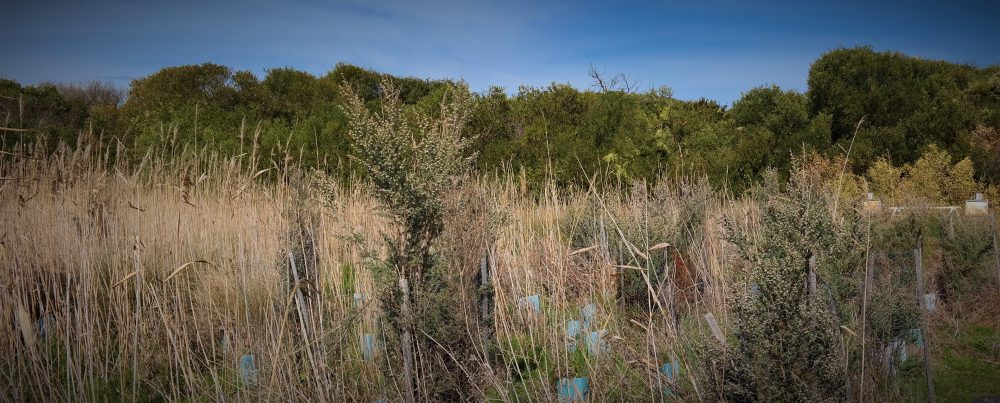
A leaf-eating challenge for revegetation at the East St Wetland, Narrawong
Revegetation efforts can be very rewarding – enhancing or creating new habitat with your own hands! But seeing a site through to becoming functional habitat is often not a straightforward process!
Nature Glenelg Trust has been helping the Narrawong District Primary School with efforts to restore a small area of Swamp Scrub on the Surry River floodplain in Narrawong since 2014. This year, the project has gained additional support through the Department of Environment, Land, Water and Planning’s Coastcare Victoria program. Just down the road from the school, it’s been a great place for students to learn about local flora and fauna and the importance of wetlands in the local landscape.
The establishment of plantings has been somewhat slow – a very eager and large local population of Swamp Wallabies are always ready to nip off young and unsuspecting plants! We have now been using 1.5 metre wire cages to protect their favourite (i.e. tasty) plants, and this year in Autumn things were looking great, with many of the Woolly Tea-trees (Leptospermum lanigerum) planted in the last few years shooting well above their cages and brimming with healthy growth.
But it was a different story in late July – many of the Tea-trees had turned into skeletons. The defoliation seemed to be occurring like a wave across the site. All over the branches were webbed nests, clumped with leaves. The culprit, appropriately named, may be the Tea-tree Web Moth (Orthaga thyrisalis). The caterpillar of these moths feed on small leaved species of the Myrtaceae family, and create communal nests where they will pupate, with a brown adult moth emerging soon after. It is suggested that younger plants are more susceptible to the pest attack – which seems to be the case. Other stands of mature Woolly Tea-trees along sections of the Surry River were found to have infestations, but these were quite small and did not appear to cause significant defoliation or stress to the plants.

Top Left: the Web Moth Caterpillar, Bottom Left: the caterpillar nest, Right: the nests on a defoliated Leptospermum
This is probably not an uncommon dilemma in trying to recreate habitat – we are trying to re-establish a healthy ecosystem that can be resilient to negative stresses – such as insect attack. But it’s not quite there yet. In the meantime, it may be that our little site needs a bit more nurturing, and more learning on our part, to get it there! A positive sign is that some of the defoliated plants have started forming small leaf buds to begin the process of re-shooting, and may survive the caterpillar attack. Many of the other revegetated species, such as Gahnias and Melaleucas are growing well. Specimens of the caterpillars have been sent to the Victorian Museum to confirm identification, and we are interested to learn more. If you know a thing or two about entomology or have seen these caterpillars around this season, please let us know!
We are holding a small working bee at the East Street Wetland in Narrawong this Saturday 15th September, from 10am to 12pm. Please join us if you can, and bring along gloves and sturdy shoes! Parking at the south end of East Street past the Primary School.
